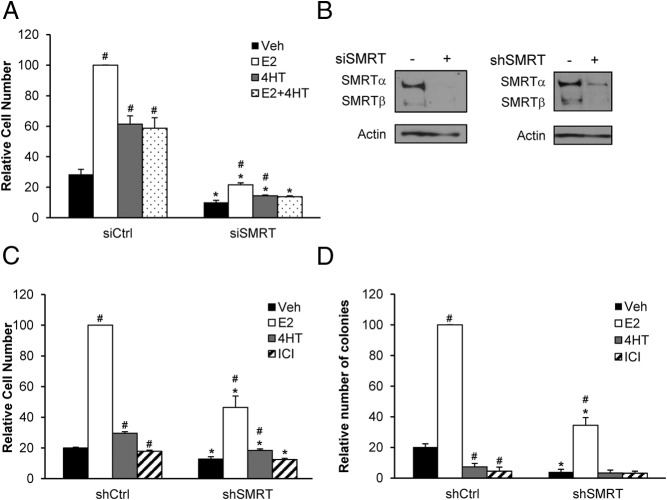Figure 1.
Depletion of SMRT by siRNA or shRNA inhibits MCF-7 cell growth. For siRNA experiments, cells were transfected with nontargeting control siRNA (siCtrl) or siRNA targeting both SMRTα and SMRTβ (siSMRT), whereas for shRNA studies stable MCF-7 cells were generated with pGIPz vectors containing either nontargeting control shRNA (shCtrl) or shRNA targeting SMRTα and SMRTβ (shSMRT). A, The day after siRNA transfection, MCF-7 cells were treated with vehicle (0.1% ethanol), 1 nM E2, 100 nM 4HT or a combination of E2 and 4HT, and 5 days thereafter cell number was determined by Beckman Coulter Particle Counter. B, Representative Western blot for SMRT knock-down achieved by siRNA transfection (left) or by shRNA in the pGIPz stable MCF-7 cell lines (right). C, The shCtrl and shSMRT cells were treated with vehicle, 1 nM E2, 100 nM 4HT, or 100 nM ICI 182,780 (ICI) and counted 5 days later using a Beckman Coulter Particle Counter. D, The growth of shCtrl and shSMRT cells were assessed by soft agar assays after 14 days of hormone treatments using Oxford Optronix GelCount. Results are average ± SEM of three experiments normalized to respective E2-treated control groups. Statistical analyses were conducted by Student's t test; #, P < .05, versus vehicle treatment within the same siRNA or shRNA group and *, P < .05 versus the corresponding ligand treatment in the siCtrl or shCtrl groups.

